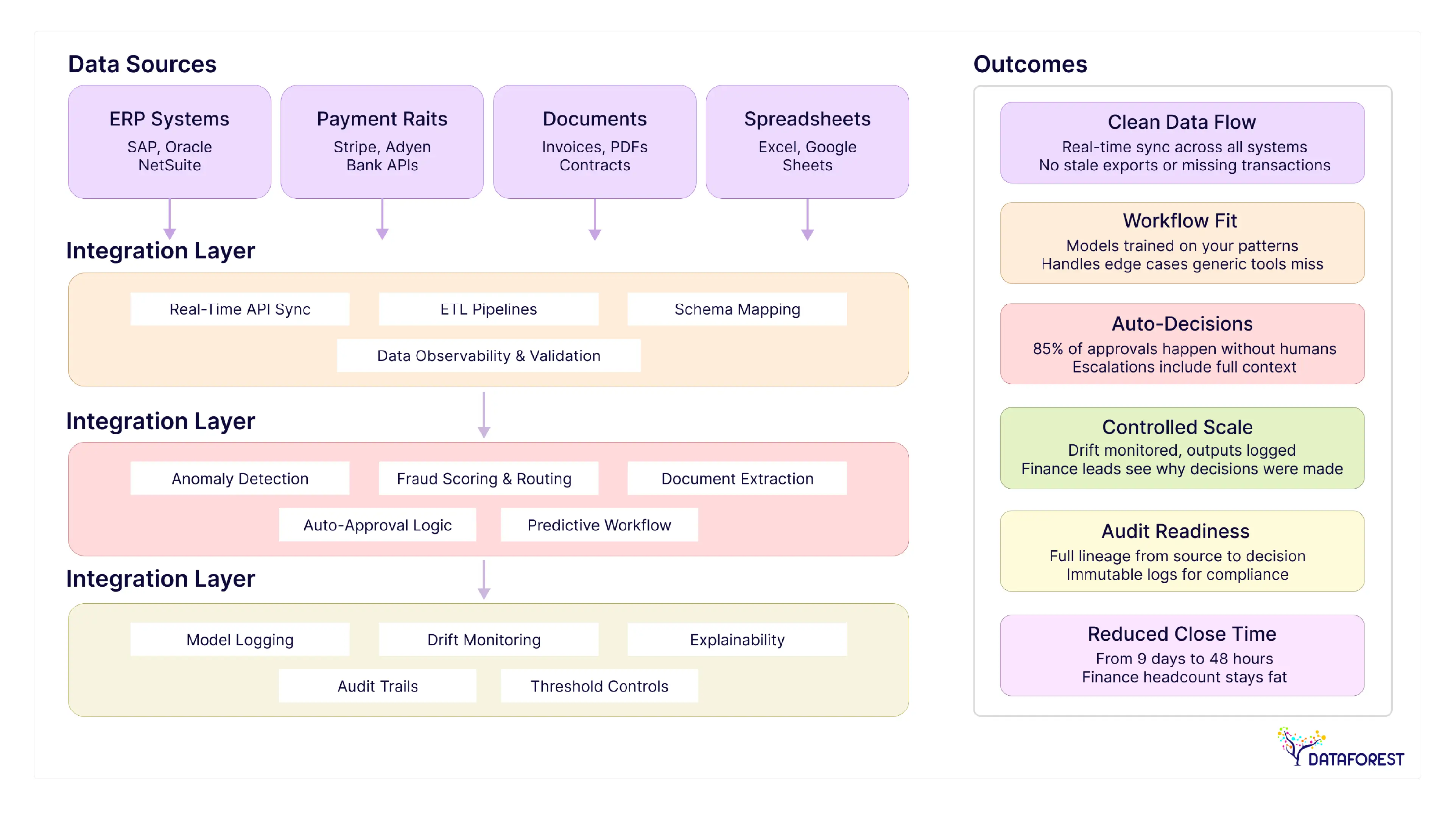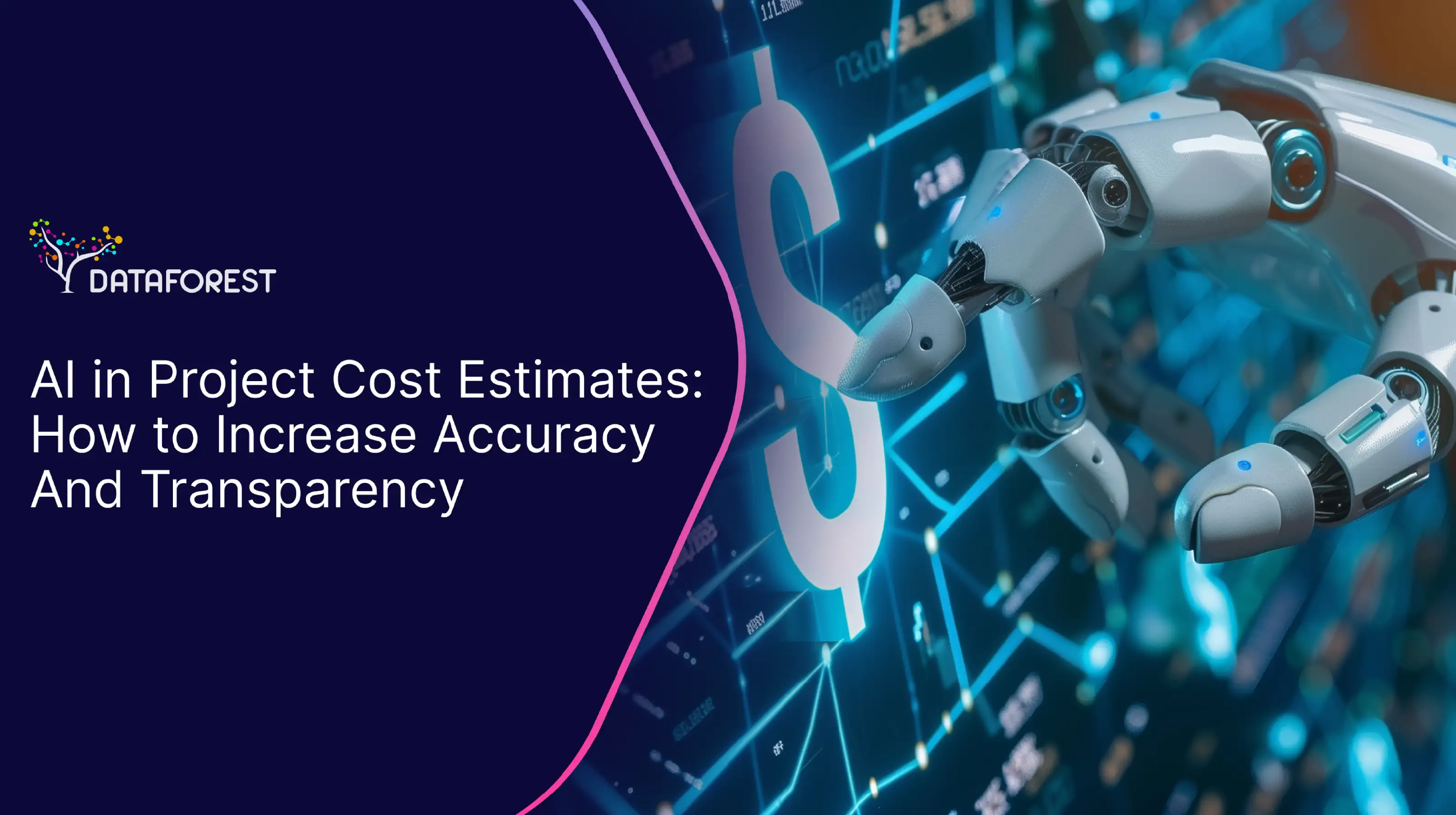A European payment processor was manually reconciling 2 million transactions monthly. They deployed ML-based anomaly detection and auto-matching rules that cut the close time from 9 days to under 48 hours. AI in finance operations kept finance headcount flat while transaction volume doubled. Schedule a call to explore how reality can be enhanced with a profitable tech solution.

How Do We Move from Automating Tasks to Making Decisions?
Finance teams start with RPA—robotic scripts that copy data between systems. That works until the script hits an edge case it wasn't trained for. Then someone has to step in manually. AI for finance operations takes it a step further by learning patterns across messy, real-world transactions. It reconciles invoices even when vendor formats change or line items don't match exactly. Over time, the system starts flagging anomalies that humans would miss—duplicate payments, misclassified expenses, or unusual vendor behavior. Finance leads can then approve or reject flagged items instead of hunting for problems themselves. The system doesn't replace judgment; it surfaces the decisions that actually matter. Eliminate manual financial bottlenecks with AI.
How to Stop Payment Failures and Fraud Before They Hit?
Finance systems react after something breaks. AI payment automation for enterprises shifts that—it routes payments around failing rails and scores fraud risk before authorization. Here's what that looks like in practice.
Route Payments Where They'll Clear
AI for finance operations doesn't just pick the cheapest payment rail. It tracks real-time success rates across processors, currencies, and transaction types. If a processor starts declining more often in a specific region, the system reroutes automatically. You avoid failed payments without manual intervention. Over time, routing logic adapts to your transaction mix—high-value wires go through stable rails, low-value transfers take the fastest path.
Score Fraud Risk at Transaction Time
Rules-based fraud detection breaks when attackers change behavior. ML models learn standard patterns for each customer, merchant, or account. They flag deviations—unusual amounts, strange timing, mismatched geolocation. Each flagged transaction gets a risk score, not a binary block. Your team reviews high-risk cases instead of chasing false positives. The model retrains on new fraud patterns without rewriting rules.
Cross-Border Processor Cuts Payment Failures by 34%
A payment processor handled transactions across 18 countries. Manual routing decisions lagged behind real-world processor outages and currency fluctuations. They deployed ML-based routing that tracked clearance rates per rail, per region, per hour. Payment failures dropped from 11% to 7% in three months. AI for finance operations stopped firefighting failed transactions and started monitoring model drift instead.
Can We Automate Approvals Without Breaking Policy?
Approval workflows still route through email chains and spreadsheets. AI for finance operations can evaluate risk, flag exceptions, and approve routine decisions without human latency. But only if the system knows what normal looks like.
Approve the Boring Stuff, Escalate What Matters
Expense and credit requests don't require human review. ML models score each one against what's happened before—vendor patterns, amount ranges, spending categories. Requests that fit the pattern auto-approve. The rest escalate with context already pulled: invoice history, category mismatches, flagged vendors. Your team handles only 15% of the volume, rather than the entire volume. The model learns from every override or approval you make. It starts catching things manual review misses—duplicate charges, vendor names that don't match contracts, and expenses coded to the wrong department. Reduce approval time with AI using AI for invoice approvals.
Route Work Based on What's About to Break
Workflows react after something's already stuck. Predictive models look at what usually happens next and adjust the sequence before you hit the bottleneck. If an invoice is likely to fail vendor validation, the system pulls backup documents first. If a payment's going to miss the cutoff, it jumps the queue. No hardcoded rules that break when volume spikes or a new vendor format shows up. AI workflow automation in finance teams keeps workflows fluid. Your team stops writing exception handlers and starts watching for model drift instead. This is an example of intelligent finance workflow automation and workflow orchestration in finance with AI.
Pull Data from Documents That Don't Match the Template
Invoice formats shift. Contracts ignore your schema. OCR struggles with scanned tables and handwritten notes. AI for accounts payable automation handles the mess. Nested line items, multi-column layouts, and rotated text. It pulls amounts, dates, and vendor names, even when the structure changes from file to file. Extracted data flows straight into an ERP or approval queue. No retyping. The system learns new formats from the corrections your team makes. Machine learning in accounts payable is key here.
The Current Question About AI For Finance Operations
Can AI Keep You Compliant Without Slowing Everything Down?
Compliance work bogs down finance ops. Manual checks miss things. AI for compliance and internal audit identifies policy breaches and regulatory drift before auditors arrive.
Track Regulatory Changes Before They Break Your Processes
Regulations shift faster than compliance teams can track. AI for finance operations monitors rule updates across jurisdictions and flags where your workflows conflict. It compares transaction patterns against current requirements in real time. No need to wait for quarterly compliance reviews to identify gaps. Your team fixes issues before they become audit findings. Accelerate financial cycle time with AI by using it to streamline compliance checks, freeing up your team to focus on strategic work.
Keep Data Clean Enough to Survive an Audit
Auditors want lineage. They want to trace every number back to its source. AI validates data integrity at ingestion, including schema checks, duplicate detection, and payment reconciliation for gaps. It logs every transformation and approval in immutable audit trails. When auditors ask questions, you pull reports instead of reconstructing history from emails. Automated payment matching with AI helps maintain this cleanliness.
Predict Compliance Risks Before They Trigger Violations
Most compliance failures happen because no one saw the pattern forming. Predictive models track transaction volume, approval timing, and vendor behavior. They flag drift before it crosses thresholds—expense patterns trending out of policy, vendors nearing sanctions lists, payments about to breach reporting limits. Your compliance team investigates risks, not violations.
Finance Operations Governance Matrix
A concise governance matrix showing ten finance-focused domains where AI for finance operations acts as the “Guardian of Governance,” with each row summarizing AI roles, required controls, key KPIs, and high-level implementation steps, plus owners and priorities for quick decision-making.
If this is your case, then arrange a call.
How to Build AI Into Finance Without Breaking What Already Works?
Finance teams operate on five disparate systems that don't integrate with each other. AI for finance operations requires clean data flows; otherwise, it halts at the first integration gap. Here's how to wire it up without ripping everything out.
Connect Systems So Data Moves
Finance data lives in ERPs, payment processors, banks, and spreadsheets. AI for finance operations is ineffective if it relies on stale exports or omits half the transactions. You need pipelines that sync in near real-time—APIs where they exist, ETL jobs where they don't. Schema mismatches can break everything, so it's crucial to map fields consistently across sources. Data observability catches breaks before models start making decisions on bad inputs. Once data flows cleanly, models see the whole picture. Integration work may not be glamorous, but it's what makes AI for finance operations reliable.
Build Models That Fit Your Workflow
Off-the-shelf AI tools assume your finance operations resemble those of others. They don't. Custom models are trained on your transaction patterns, vendor mix, and approval logic. They handle edge cases that generic tools miss—multi-entity reconciliation, non-standard payment rails, and regional tax rules. You own the model, so you control retraining schedules and feature updates—no waiting for a vendor roadmap. Custom doesn't mean slow—it means the AI for finance operations fits how your team works.
Scale AI Without Losing Control
AI for finance operations in production requires governance to prevent it from drifting into chaos. Model outputs get logged. Predictions get reviewed. Drift gets monitored. You define thresholds for when a model escalates instead of deciding. Transparency matters—finance leads need to understand why a transaction was flagged or an invoice was routed. Explainability isn't optional when you're moving money, as you add models, governance scales with them: centralized monitoring, decentralized deployment.

What Is the Way to Move from Assessment to AI for Finance Operations?
How ready is your organization to adopt AI for finance operations, and what steps will bridge the gap between evaluation and full deployment? This guide breaks the journey into clear stages so leaders can assess maturity, plan AI-driven transformation, and choose the right partners. Use it to prioritize actions, mitigate risk, and accelerate measurable value.
Assessing Financial Workflow Maturity
- Start by mapping end-to-end finance processes (finance back-office automation with AI includes accounts payable/receivable, general ledger, reconciliations, close, forecasting, compliance) and document inputs, owners, timelines, and exception rates.
- Score processes on criteria such as automation level, data availability and quality, cycle time, decision latency, and frequency of manual interventions to create a baseline maturity profile.
- Identify high-impact pain points and bottlenecks where AI for finance operations could offer measurable improvements (e.g., invoice matching, anomaly detection, cash forecasting).
- Evaluate technical readiness: data infrastructure, integration points, APIs, and existing RPA or automation tools that AI models would need to access.
- Capture organizational readiness too—skills, change appetite, governance, and risk tolerance—to ensure technical work aligns with people and process changes.
Designing the Path to AI-Driven Transformation
- Define clear business outcomes (reduced close time, lower DSO, fewer payment errors, predictive cash forecasts) and prioritize use cases based on ROI, feasibility, and regulatory risk.
- Develop a phased roadmap that begins with low-risk, high-value pilots to validate assumptions and build stakeholder buy-in before scaling to core systems.
- Specify data and model requirements: sources, features, labeling needs, retraining frequency, performance metrics, and explainability constraints for auditors—the rule in the AI for finance operations.
- Plan integration and operations: how models will be deployed (batch vs. real-time), monitoring, alerting for drift, incident response, and a process for human-in-the-loop escalation.
- Incorporate change management: training for finance staff, updated process documentation, KPIs for adoption, and a governance forum to review ethics, compliance, and model decisions.
Partnering for Successful AI Adoption
- Decide whether to build, buy, or co-develop by comparing internal capabilities, time-to-value, and long-term maintenance responsibilities.
- Evaluate vendors and consultants on domain expertise in finance, track record with similar implementations, data security/compliance posture (SOC2, ISO, GDPR), and model transparency.
- Structure commercial and contractual terms to include SLAs, performance guarantees, IP ownership, and clear handover plans for operations and knowledge transfer.
- Establish a cross-functional steering team (finance, IT, legal, risk, procurement) to define AI for finance operations partner roles, responsibilities, and escalation paths, ensuring alignment and speed.
- Plan for continuous collaboration post-deployment: joint retrospectives, roadmap updates, ongoing data sharing, and periodic third-party audits to sustain performance and trust.
AI That Cleans Up Finance Operations Instead of Complicating Them
Finance teams don’t struggle with models—they struggle with scattered, unreliable data. DATAFOREST starts there, building pipelines that pull and normalize data from ERPs, core banking systems, trading tools, and external feeds. Once the data behaves, we deploy models for fraud detection, credit risk, and anomaly spotting that fit into existing approval flows instead of becoming side projects. Back-office work—report prep, KYC checks, document parsing, reconciliations—gets handed off to agentic automations that don’t mistype or forget. Dashboards and portals provide decision-makers with live numbers, eliminating the lag between planning and reality. The net effect is fewer manual hours, tighter controls, and finance teams that can act instead of clean up.
Please complete the form to use AI for finance operations.
Questions on AI-Powered Financial Automation
How does AI handle exceptions or anomalies that don't fit predefined financial rules?
Models flag outliers instead of forcing them into categories. Your team reviews flagged transactions with full context—vendor history, amount deviation, and approval patterns. The AI for finance operations learns from each review, so it has fewer false positives over time.
What are the biggest security concerns when applying AI to sensitive financial data, and how can they be mitigated?
Model theft and data poisoning are real risks. Encrypt data in transit and at rest, isolate model serving from the main pipeline, and audit access logs. Run periodic adversarial tests to catch injection attacks before they cause damage—the core of AI for finance operations.
How can AI-driven financial automation coexist with legacy ERP and accounting systems?
Build API layers between legacy systems and new models. Don't rip out working infrastructure—wrap it. You extract data via APIs, run models separately, then push decisions back into the legacy system through batch uploads or webhooks. Legacy remains stable as AI for finance operations operates alongside it.
How do regulatory bodies view AI-generated financial decisions and reports — are they legally auditable?
Regulators want explainability and lineage. You need immutable logs that show why each decision was made, including documentation of model training data, retraining schedules, and threshold changes. Most jurisdictions accept AI for finance operations if you can prove the reasoning—not magic, but auditable logic.
Can AI models adapt to region-specific tax laws or financial regulations automatically?
Models can flag regulatory drift when rules change. You still need engineers to map new regulations into features and retrain. AI for finance operations ends at detection—human judgment handles legal interpretation. Without that check, you risk compliance failures across multiple jurisdictions.
How does AI-driven finance process optimization reduce manual work without creating new bottlenecks?
Most teams optimize one step, creating chaos downstream. AI for finance operations works across the whole pipeline—it routes payments, flags anomalies, escalates exceptions, all in sequence. Without orchestration, you simply redistribute the workload rather than reducing it.
What makes machine learning for reconciliation in finance more reliable than rule-based matching?
Rules are broken when vendors change invoice formats or when amounts shift slightly. AI for finance operations learns patterns instead—it matches invoices even with fuzzy data, schema drift, or edge cases. Rules need updates every time reality changes; models adapt on their own.





.svg)
.webp)















